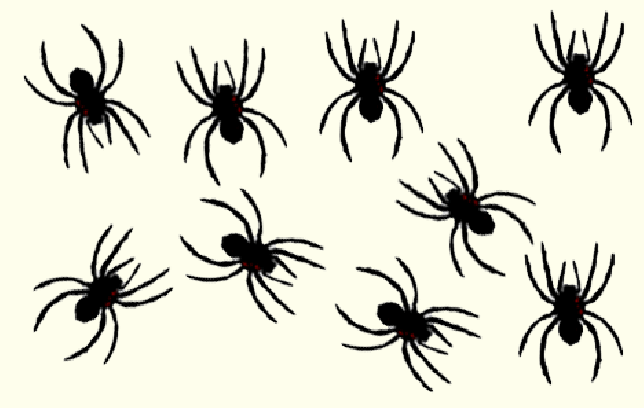Black Widow vs False Widow: Identification
The black widow spider Latrodectus has a cousin that mimics it's distinctive markings in order to dissuade predation. Called the false widow, or Steatoda, these spiders are harmless but commonly mistaken for their dangerous relatives (though it is only female Latrodectrus that are venomous). There are ways to tell the difference, though, if you know what to look for.
The false widows tend to have flatter abdomens, on average, which have a slight purple color. Another major difference between the spiders is their legs. Latrodectus (black widows) have two long front legs while Steatoda (false-widows) do not. They have thinner, more spindly-looking legs than Latrodectus, whose legs are sturdier than most spiders.
Once they reach full adulthood, black widow females tend to be a deep, glossy black on their backs (dorsal surface), with a red or orange hourglass shape on their bellies (ventral surface). Often found hanging upside-down in their webs, this tell-tale sign of Latrodectus is usually easy to spot. Since the hourglass mark is visible from early-on in the widow's development, if no hourglass can be seen on the belly, you've probably got a Steatoda.
The backs of both species can be marked in younger females, making a look underneath much more useful for identification. Dorsal surfaces on Letrodectus can be a central red line, a series of red or yellow spots, or both. Young Steatoda backs may feature a central red or white line, often reaching back from a curved white line around the front, making a T shape.
The back two segments, called the tarsus and meta-tarsus, are much longer on Latrodectus. have much longer tarsus (that’s the final segment) and much longer meta-tarsus (that’s the penultimate leg segment). The false widow's abdomen, called the opisthosoma has a rounded, egg shape and often hangs over the main body, called the cephalothorax. Steatoda cephalothorax are smaller in comparison to the rest of the body. The false widow also tends to be smaller overall than Latrodectus, but not always.
The key is the red or orange hourglass on the underside of the spider. Sometimes it is more like two separated triangular shapes. If you see this shape on the underside of the spider, it's a black widow. If this shape is not there, it's a harmless false widow, even if there is some lighter markings visible.




Wonder Studios maker Kevin Feige has expressed that it is putting a great deal of time and exertion into influencing this motion picture to right: the character has, all things considered, been showing up in these films for just about 10 years, so she merits an appropriate motion picture. In excess of 65 chiefs were met to go up against the task, in a procedure that assumed control a large portion of a year.
been showing up in these films for just about 10 years, so she merits an appropriate motion picture. In excess of 65 chiefs were met to go up against the task, in a procedure that assumed control a large portion of a year.
well done my dear, very nice article.
Black spider OMG !! Hey @pinkspectre keep posting.
Best Regards. If you can then visit my blog i am photographer.
Thank you.
Wow, thanks for this. Never even knew!
What an education. This is new to me. Most of the times I observe a spider it's on the web which makes seeing the belly easy.